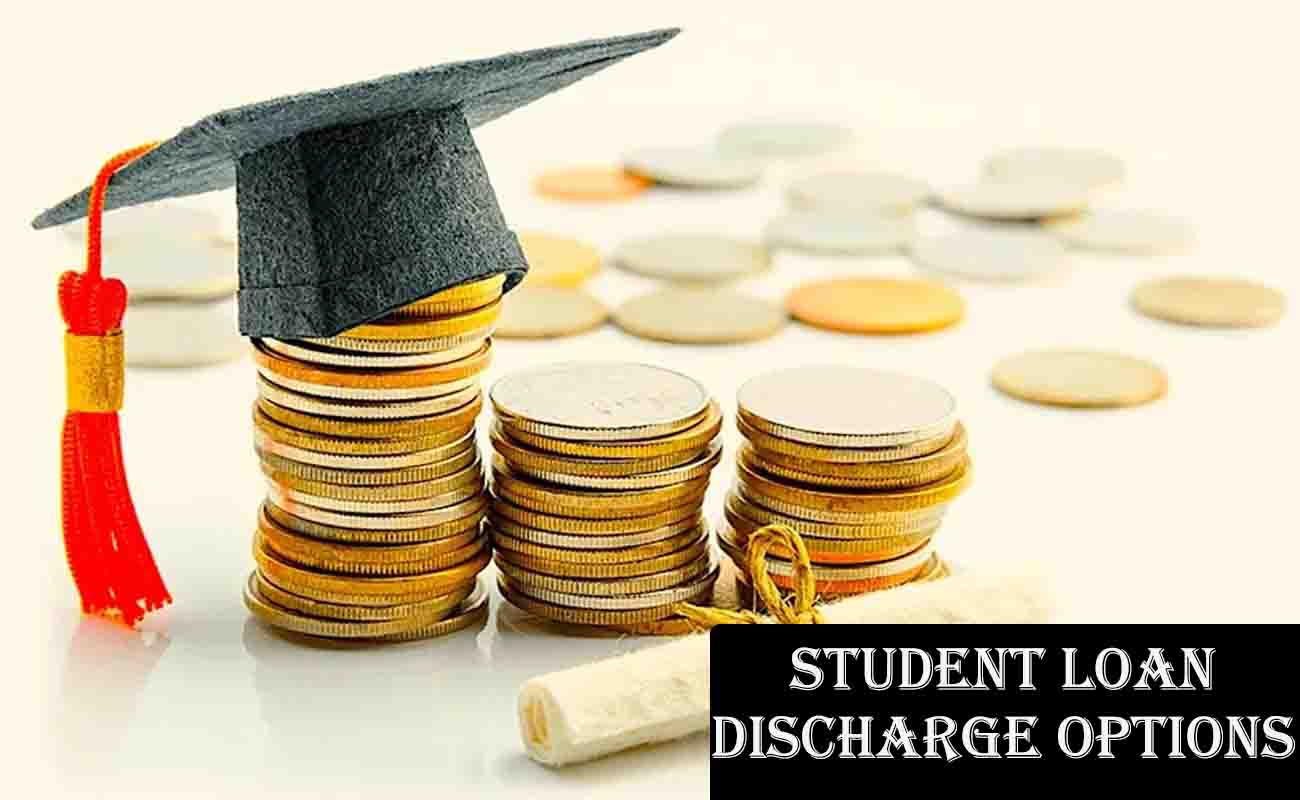I will discuss Student Loan Discharge Options in this post. As someone who’s grappled with the weight of student loans, I know how much of a burden they can feel. The good news? There are student loan discharge options that might lift that weight, depending on your situation.

Whether you’re a teacher, a public servant, or facing unique challenges like disability or a school closure, there’s a chance you could qualify for relief. In this guide, I’ll walk you through the various student loan discharge options in simple, everyday language, so you can figure out what might work for you. Let’s explore these possibilities together.
What Are Student Loan Discharge Options?
Let’s start with the basics. Student loan discharge, forgiveness, and cancellation all mean the same thing: you’re no longer responsible for repaying some or all of your student loan debt. These terms are often used interchangeably, but they all point to the same outcome: freedom from your loan under specific circumstances.
These options are mostly for federal student loans, as private loans rarely qualify for discharge outside of rare cases like bankruptcy. Understanding these options can be a game-changer if you’re struggling to keep up with payments or facing unique life challenges.
Types of Student Loan Discharge Options
There are several pathways to have your student loans discharged. Below, I’ll break down the most common student loan discharge options, including who qualifies, how to apply, and what you can expect.
1. Income-Driven Repayment (IDR) Forgiveness
If your monthly loan payments are eating up too much of your income, an Income-Driven Repayment (IDR) plan could be a lifeline. These plans adjust your payments based on your income and family size, sometimes dropping them as low as $0. After 20 or 25 years of payments, any remaining balance is forgiven.
- Eligibility: Most federal student loans, like Direct Loans or federally managed FFEL Program loans, are eligible. You’ll need to enroll in an IDR plan, such as Income-Based Repayment (IBR), Pay As You Earn (PAYE), or Revised Pay As You Earn (REPAYE). Private loans don’t qualify.
- How to Apply: Contact your loan servicer or apply through Federal Student Aid. You’ll need to submit income information annually to stay enrolled.
- Forgiveness Timeline: Forgiveness happens after 20 or 25 years (240 or 300 months), depending on the plan and when you took out your loans. A one-time adjustment may count past months in repayment, certain deferments (pre-2013), or extended forbearances toward this timeline.
- Key Notes: Forgiveness is taxable as income, so you might owe taxes on the forgiven amount. Beware of scams—there’s no fee to apply for IDR forgiveness.
2. Public Service Loan Forgiveness (PSLF)
If you work in public service, the Public Service Loan Forgiveness (PSLF) program could wipe out your loans after 10 years of qualifying payments. This is a fantastic option for those dedicated to serving their communities.
- Eligibility: You must have federal Direct Loans and work full-time (at least 30 hours per week) for a qualifying employer, like a government agency or certain nonprofits. You also need to make 120 qualifying payments (about 10 years) under an IDR plan. FFEL or Perkins Loans can qualify if consolidated into a Direct Consolidation Loan.
- How to Apply: Use the PSLF Help Tool at Federal Student Aid to verify your employer and track payments. Submit employment certification forms annually or when you change jobs.
- Forgiveness Amount: After 120 qualifying payments, your entire remaining Direct Loan balance is forgiven, tax-free.
- Key Notes: Payments don’t need to be consecutive, and paused payments under certain conditions (like the COVID-19 forbearance) may count. Always verify your employer’s eligibility to avoid surprises.
3. Teacher Loan Forgiveness
Teachers working in low-income schools have a special opportunity to reduce their loan burden through Teacher Loan Forgiveness.
- Eligibility: You must teach full-time for five complete and consecutive academic years in a low-income elementary school, secondary school, or educational service agency. You need Direct Loans or FFEL Program loans. Certain subjects, like math or special education, may qualify for higher forgiveness amounts.
- How to Apply: Submit the Teacher Loan Forgiveness Application through Federal Student Aid. Your school must be listed in the Department of Education’s directory of low-income schools.
- Forgiveness Amount: Up to $17,500, depending on your teaching subject and school designation.
- Key Notes: You can’t double-dip with PSLF for the same teaching period, so choose the program that best fits your goals.
4. Total and Permanent Disability Discharge
If you’re unable to work due to a permanent disability, you may qualify for a Total and Permanent Disability (TPD) discharge, which can erase your entire loan balance.
- Eligibility: You must be totally and permanently disabled, as verified by the Department of Veterans Affairs, Social Security Administration, or a physician. Veterans with a service-connected disability may qualify automatically.
- How to Apply: Apply with supporting documentation to your loan servicer or through Disability Discharge. Note that processing may be paused until Spring 2025 due to system updates.
- Forgiveness Amount: Your full loan balance is discharged, but you’ll face a three-year monitoring period to confirm your disability status. Loans may be reinstated if you earn above a certain income during this time.
- Key Notes: You can decline automatic discharge if it affects state tax liabilities. Always consult a tax professional.
5. Closed School Discharge
If your school closed while you were enrolled or shortly after you left, you might be eligible for a Closed School Discharge.
- Eligibility: You must have been enrolled at the time of closure or withdrawn within 180 days before the closure without completing your degree. This applies to federal student loans taken for that school.
- How to Apply: Contact your loan servicer to request an application and provide proof of enrollment.
- Forgiveness Amount: The full loan balance tied to the closed school is discharged, and you may receive a refund for payments already made.
- Key Notes: Continue making payments while your application is processed to avoid default.
6. Borrower Defense to Repayment
If your school misled you or engaged in misconduct, like false advertising, you could qualify for Borrower Defense to Repayment.
- Eligibility: You must prove the school’s actions directly harmed you, such as misrepresenting job placement rates or program quality. This applies to federal student loans.
- How to Apply: File a claim at Federal Student Aid. Note that some decisions are on hold due to legal challenges.
- Forgiveness Amount: Varies based on the case; you may receive partial or full discharge.
- Key Notes: The process can be lengthy, so patience is key. Keep records of any evidence, like school advertisements or emails.
7. Perkins Loan Cancellation and Discharge
Perkins Loans, though less common, offer cancellation options for specific professions or circumstances.
- Eligibility: You may qualify if you work in public service, teach in low-income schools, or have a disability. Eligibility varies by program.
- How to Apply: Contact your Perkins Loan servicer for specific instructions and applications.
- Forgiveness Amount: Up to 100% of the loan, often incrementally based on years of service.
- Key Notes: Perkins Loans are rare, as the program ended in 2017, but existing loans may still qualify.
8. Student Loan Death Discharge
If you pass away, your federal student loans are discharged, relieving your family of the burden.
- Eligibility: A family member or estate representative must submit a death certificate or equivalent documentation to the loan servicer.
- How to Apply: Contact the loan servicer to submit the required paperwork.
- Forgiveness Amount: The entire loan balance is discharged.
- Key Notes: This also applies to Parent PLUS Loans if the borrower or student passes away.
9. Bankruptcy Discharge
Discharging student loans through bankruptcy is rare but possible in extreme cases.
- Eligibility: You must prove that repaying the loan would cause “undue hardship,” a high legal standard. This applies to both federal and private loans.
- How to Apply: File for bankruptcy and request a discharge through the court, typically with legal assistance.
- Forgiveness Amount: Varies, but typically the full loan balance if approved.
- Key Notes: This is a complex process, and success is not guaranteed. Consult a bankruptcy attorney for guidance.
How to Apply for Student Loan Discharge
Applying for student loan discharge options depends on the program, but here’s a general roadmap to get you started:
- Identify Your Program: Review the eligibility criteria above to find the best fit for your situation.
- Gather Documentation: This might include employment records, medical certifications, school enrollment proof, or a death certificate.
- Contact Your Loan Servicer: They’ll guide you to the right application forms and process. You can also visit Federal Student Aid for applications and tools like the PSLF Help Tool.
- Submit and Follow Up: Send your application and keep making payments until you receive confirmation to avoid penalties.
- Watch for Scams: Never pay a fee for discharge assistance. Official communications come from verified emails like noreply@studentaid.gov.
FAQs About Student Loan Discharge
Q: Can private student loans be discharged?
A: Private loans are rarely eligible for federal discharge programs. Bankruptcy is an option, but it’s tough to prove undue hardship. Contact your lender to explore other relief options.
Q: Will discharged loans hurt my credit score?
A: Most discharge programs don’t negatively impact your credit, as the loan is closed as “paid” or “forgiven.” Check with credit agencies to confirm.
Q: Is student loan discharge taxable?
A: It depends. PSLF and death discharges are typically tax-free, but IDR forgiveness may be taxable as income. Consult a tax professional for clarity.
Q: How long does the discharge process take?
A: Timelines vary. Death discharges are often quick, while Borrower Defense or TPD discharges can take months or years, especially with legal or system delays.
Q: What if I’m in default?
A: You may need to consolidate or rehabilitate defaulted loans before applying for forgiveness. Check Federal Student Aid for options.
Conclusion
Exploring student loan discharge options can open doors to financial relief, whether you’re a public servant, a teacher, or facing challenges like disability or school closure. Each program has its own rules, so take the time to review your eligibility and gather the right documents.
If you’re unsure where to start, reach out to your loan servicer or visit Federal Student Aid for guidance. With patience and the right information, you can find a path to lighten your loan burden.
Key Citations
- Federal Student Aid – Manage Loans Forgiveness Cancellation
- Consumer Financial Protection Bureau – Student Loan Forgiveness
- NerdWallet – 14 Student Loan Forgiveness Programs for 2025
- Federal Student Aid – Total and Permanent Disability Discharge
- Disability Discharge – System Outage Information
- Edfinancial Services – Complete List of Discharge Options
- Federal Student Aid – Public Service Loan Forgiveness
- Federal Student Aid – Income-Driven Repayment Plans
- Federal Student Aid – Borrower Defense to Repayment
- Federal Student Aid – Teacher Loan Forgiveness Application
- Federal Student Aid – Get Out of Default
